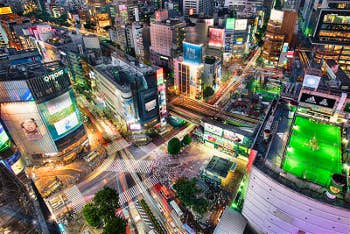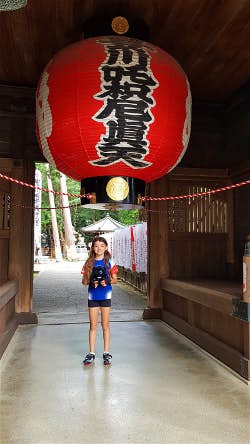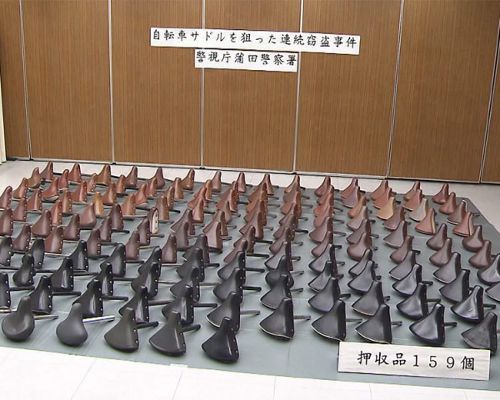 訪日する外国人が増えています。
訪日する外国人が増えています。October 19, 2019
日本は意外にも知られている
 訪日する外国人が増えています。
訪日する外国人が増えています。 2011年に620万人だった訪日外国人は、2018年に3千100万人と5倍にも伸びています。今年はさらに増えるでしょう。ひと頃の中国人の爆買いというフレーズは聞かれなくなりましたが、それでも消費額は4.5兆円にも及び、日本経済への波及効果は大きなものがあります。
 一部では観光公害、オーバーツーリズムなども指摘されていますが、地方にも大きな恩恵が及んでいます。最近は東京・大坂間の、いわゆるゴールデンルートだけでなく、リピーターを中心に地方を訪れる外国人が増える傾向にあることも、各地で期待が高まる背景にあります。
一部では観光公害、オーバーツーリズムなども指摘されていますが、地方にも大きな恩恵が及んでいます。最近は東京・大坂間の、いわゆるゴールデンルートだけでなく、リピーターを中心に地方を訪れる外国人が増える傾向にあることも、各地で期待が高まる背景にあります。
その経済効果を考えれば、各地方自治体がインバウンドの獲得に力を入れるのも当然でしょう。各地で、その地域の特徴を活かした誘致策が展開されています。このブログでは度々取り上げていますが、自転車、サイクリングを前面に押し出してインバウンド誘致につなげようとするところも増えています。
現在、ラグビーW杯に多くの外国人が訪れていますし、来年には東京オリンピックがあります。政府の観光立国政策も手伝い、日本の伝統文化や豊かな自然、治安の良さ、人々の親切さ、アニメやポップカルチャーなど、日本の魅力が広く知られることになったことも、訪日外国人の増加につながっていると思います。
ところで、海外の人の興味は、こうした日本の魅力にとどまりません。日本を訪れようと考える人なら、日本での宿泊や移動など、旅行事情にも関心を寄せるでしょう。そして、日本人からすると意外に感じるほど、日本の自転車事情が海外に向けて発信されています。いくつか例を挙げてみましょう。
こちらは、日本での移動方法について詳しく紹介された記事です。当然ながら電車やバス、クルマや新幹線などの交通手段が紹介されていますが、一番最初に出て来るのは自転車なのが意外です。日本の自転車の特徴としてママチャリのこと、長距離には向かないことなど、詳しく書かれています。
ニュージーランド人の親子がラグビーW杯の観戦のため、日本中をサイクリングしているという記事です。開催期間だからというのもありますが、日本を自転車で旅行することにも関心が集まっているようです。日本を自転車で移動してみたいと考える人も少なくないのでしょう。これは、理解できます。
ところが、こちらは不登校になった娘と毎年夏休み、12年にもわたって、父娘で自転車旅行をしている日本人という記事です。日本の海外向けメディアではありますが、このような記事をわざわざ海外に向けて配信していることに驚きます。このような内容に海外の人は興味を示すのでしょうか。
こちらは、少し前にも取り上げた、「ママチャリロード」の記事です。日本人なら、このユニークさが理解できると思いますが、外国人が読んで、その意味合いを理解できるのでしょうか。明らかに国内向けの話題だと思うのですが、海外に向けても配信されています。
こちらは、少し前に日本のニュースとしても取り上げましたが、自転車のサドルを159個も盗んで捕まった男の記事です。報じているのは、パキスタンのメディアです。日本人なら呆れるニュースですが、パキスタン人は、この事件のどこに関心があるのでしょうか。
こちらは、日本の自転車保険の加入を義務付ける条例のニュースです。これも再三取り上げましたが、外国人に関係があるニュースとは思えません。こちらは日本のニュースを専門に扱うメディアではあるものの、こんなニュースまで海外で報じられていることに驚きます。
こちらは、東京の放置自転車についての記事です。これも、日本に住む外国人ならともかく、海外の外国人が興味を示す記事とは思えません。もちろん、同じように放置自転車に悩んでいる都市はあると思いますが、このような日本の自転車事情まで海外で報じられています。
それだけ、日本に対する関心が高まっていると言えるのかも知れませんが、このような、日本人以外にとって意味があるとは思えないような記事まで、海外に発信されていることに驚きます。日本での移動手段としての自転車ならともかく、放置自転車に苦慮していることまで、海外に知られていることになります。
たしかに、日本人でも知らないような話題や見どころを外国人が知っている例はあります。日本人には当たり前でも、外国人には珍しいこともあるでしょう。日本に行ったら見てみたいものならともかく、日本の放置自転車が減ったことを知って、どうしようというのでしょう。いくらネットの記事とは言え、関心が寄せられるのでしょうか。
こちらは、岐阜県恵那市の国道のトンネルで、自転車2台がクルマに衝突され、1人が死亡した事故のニュースです。このようなローカルな事故まで取り上げられています。私は自転車関連のニュースを見ているほうだと思いますが、この事故のことは知りませんでした。
 この記事には多くのコメントが寄せられており、関心の高さがうかがえます。でも、サイクリストが犠牲になる事故は海外でも多数起きているはずです。トンネル内ということはあるとしても、日本での自転車による移動に関心のある人は少なくないようです。
この記事には多くのコメントが寄せられており、関心の高さがうかがえます。でも、サイクリストが犠牲になる事故は海外でも多数起きているはずです。トンネル内ということはあるとしても、日本での自転車による移動に関心のある人は少なくないようです。
日本へ行って自転車に乗ろう、自転車で旅行しようと考えている人は気になるとしても、日本の自転車事情自体に関心がある人は限られると思います。しかし、意外なことに、日本人が思いもよらないような自転車事情まで海外に配信され、知られているようです。
日本に対する関心が世界的に高まり、訪日外国人が飛躍的に増えています。今はSNSなどもありますし、口コミも含め、日本の見どころ、魅力が海外に伝わっているのは間違いないでしょう。特に宣伝をしているわけではないのに、訪日外国人が押し寄せる場所もあります。
一方、日本の自転車事情も、ネガティブな面も含めて伝わっていることになります。地域振興のためにサイクリングをアピールする地方自治体は増えていますが、うわべだけアピールしても、日本に行こうと考えている人には、その不自由さなどを見透かされている可能性があります。
インバウンドにアピールしようとしても、基本的な自転車インフラが貧弱だったり、事故などのリスクが高いと判断されれば、自転車での旅行では、その地域は敬遠される恐れがあります。日本人が外国人は知らないだろうと思っていることが知られており、注目されている可能性もあります。
日本では普通のこと、問題とは思っていない部分に外国人は懸念を抱いているかも知れません。地域のアピールとして、とかく景色や名所、おもてなしなどが意識されがちですが、自転車での走りやすさ、基本的な自転車インフラの整備環境などにも気を配る必要がありそうです。
◇ ◇ ◇
さあ明日はいよいよ南ア戦です。先月のテストマッチで4年前のリベンジをされたので、その大敗の雪辱を是非。
 一部では観光公害、オーバーツーリズムなども指摘されていますが、地方にも大きな恩恵が及んでいます。最近は東京・大坂間の、いわゆるゴールデンルートだけでなく、リピーターを中心に地方を訪れる外国人が増える傾向にあることも、各地で期待が高まる背景にあります。
一部では観光公害、オーバーツーリズムなども指摘されていますが、地方にも大きな恩恵が及んでいます。最近は東京・大坂間の、いわゆるゴールデンルートだけでなく、リピーターを中心に地方を訪れる外国人が増える傾向にあることも、各地で期待が高まる背景にあります。その経済効果を考えれば、各地方自治体がインバウンドの獲得に力を入れるのも当然でしょう。各地で、その地域の特徴を活かした誘致策が展開されています。このブログでは度々取り上げていますが、自転車、サイクリングを前面に押し出してインバウンド誘致につなげようとするところも増えています。
現在、ラグビーW杯に多くの外国人が訪れていますし、来年には東京オリンピックがあります。政府の観光立国政策も手伝い、日本の伝統文化や豊かな自然、治安の良さ、人々の親切さ、アニメやポップカルチャーなど、日本の魅力が広く知られることになったことも、訪日外国人の増加につながっていると思います。
ところで、海外の人の興味は、こうした日本の魅力にとどまりません。日本を訪れようと考える人なら、日本での宿泊や移動など、旅行事情にも関心を寄せるでしょう。そして、日本人からすると意外に感じるほど、日本の自転車事情が海外に向けて発信されています。いくつか例を挙げてみましょう。
When living or working in Japan, one big priority will be finding the perfect method of transportation for you. There are a ton of options available. In this article we’ll go over the commonly available methods of transportation, their pros and cons, and the costs.
This article will cover: Bicycles, Cars, Trains, Busses, Motorcycles & Scooters, and Trams
Bicycle
In Japan, 78% of households own bikes for some reason or another. 15% of commuters require a bike for some or all of the trip. If you live in the city, a bike will be particularly helpful. Once you’ve got your bike, all you have to do is pay a small registration fee at the store and you’re ready to go.
The most common bicycle you’ll find in Japan is the “mamachari,” (mom bike) so named because many mothers will attach one or two child seats on these bikes to take their children wherever they need to go. This is the bike that you’ll probably be buying, unless you’re riding for sport or exercise rather than for daily life.
Mamachari: Bike features
Comes with a lock
Comes with a light (For a slightly higher price, you can have a light that will automatically turn on and off depending on the time of day. Handy, because lights are a requirement, and if you’re riding at night without them, you WILL be stopped by the police.)
Usually comes with a basket (Useful for groceries)
・・・
(Saturday, October 12, 2019 Izanau)
こちらは、日本での移動方法について詳しく紹介された記事です。当然ながら電車やバス、クルマや新幹線などの交通手段が紹介されていますが、一番最初に出て来るのは自転車なのが意外です。日本の自転車の特徴としてママチャリのこと、長距離には向かないことなど、詳しく書かれています。
All eyes are on Japan at the moment, as the Rugby World Cup kicks up a gear and gets into full swing. Some fans have had to stay at home to watch the games, while others have travelled there to immerse themselves in the spirit of the tournament. One 11-year-old girl has beat everyone however, as she is cycling from Tokyo to Osaka to keep up with the games.
Mariya Budd was at her grandparents home in Auckland last year with her father, Stephen. The family began watching a programme on Discovery Channel about the old Tokyo to Kyoto walking road the Nakasend?, and the conversation quickly turned to the logistics of actually doing it. After that initial idea was sparked, the father and daughter spoke at length about the idea, and eventually made a plan ? to cycle another route ? from Tokyo Tower to Osaka (near to where Mariya’s grandmother lives) during the Rugby World Cup to follow Stephen’s cousin Dean Budd, who just so happens to be on the Italian squad.
“I was born in Japan so it was a great place for an adventure for me and to help with my Japanese. I go to school in Japan for one month every year, and my school in Australia was OK with me taking an extra few weeks after the Australian school holidays to do this,” Mariya told Lonely Planet. It took Mariya and Stephen awhile to figure out the itinerary, as they wanted to avoid long cycling days and too many hills. They used Google Maps to set a route.
・・・
(October 14,2019 Lonely Planet)
ニュージーランド人の親子がラグビーW杯の観戦のため、日本中をサイクリングしているという記事です。開催期間だからというのもありますが、日本を自転車で旅行することにも関心が集まっているようです。日本を自転車で移動してみたいと考える人も少なくないのでしょう。これは、理解できます。
TOKYO -- A father who has been taking his daughter on long-distance bicycle trips every summer since she became unable to attend elementary school has shared his experiences, hoping they may encourage parents with children who aren't at school.
Shigeo Onda, 54, and his daughter Harune, now a 20-year-old university student, went to the Kansai region in western Japan on their 12th bicycle trip this year.
"We've experienced kindness from many people during our trips, and they have been good experiences," stated Onda, a worker of a nursing facility in the capital's Itabashi Ward.
Harune became unable to attend school from the autumn of third grade, after she was subjected to physical abuse by a male student at an elementary school run by Itabashi Ward. Onda felt that the school's response was insincere and did not force his daughter to return.
One day, the two visited a library and found a picture book about a father and daughter traveling on their bikes. When Onda suggested they do something similar, his daughter responded with a nod.
In the summer of 2008, Onda took his daughter to the Noto Peninsula in Ishikawa Prefecture on the Sea of Japan coast for their first trip. They cycled on a mountain path, roads without street lights at night, and even stayed at a campground. Onda recalls thinking, "There probably won't be a next time," as the route was very harsh for the physical capacity of a primary school girl.
・・・
(September 24, 2019 Mainichi Japan)
ところが、こちらは不登校になった娘と毎年夏休み、12年にもわたって、父娘で自転車旅行をしている日本人という記事です。日本の海外向けメディアではありますが、このような記事をわざわざ海外に向けて配信していることに驚きます。このような内容に海外の人は興味を示すのでしょうか。
HIMEJI, Hyogo Prefecture--An easier-to-use road bike was developed for elderly people hoping to get back in the saddle of cycling and women who are hesitant to buy the ubiquitous “mamachari” (mom’s bike).
The new bike produced by Koumei Co., which makes and sells bicycles here, eliminates the often troublesome and potentially painful top tube that connects the handlebars and the seat post.
The new model also features sports-type wheels and components so cyclists can enjoy speedy rides.Named Mamachari Road, the road bike was designed in the image of a mamachari, the popular bicycle that features baskets for grocery shopping, seats for transporting small children and other practical parts.
According to Koumei, road bikes are growing in popularity among elderly individuals who are increasingly conscious of their health and weight.
But typical road bikes force cyclists to raise one leg over the top tube for mounting or dismounting. Many elderly people are reluctant to buy road bikes out of concerns about “collapsing and breaking bones,” a Koumei official said.
・・・
(September 27, 2019 The Asahi Shimbun)
こちらは、少し前にも取り上げた、「ママチャリロード」の記事です。日本人なら、このユニークさが理解できると思いますが、外国人が読んで、その意味合いを理解できるのでしょうか。明らかに国内向けの話題だと思うのですが、海外に向けても配信されています。
TOKYO (Web Desk) - A 61-year-old man from Tokyo’s Ota Ward was recently arrested by Japanese police for allegedly stealing no less than 159 bicycle seats, as a bizarre way of taking revenge for having his own seat stolen last year.
Earlier this month, Akio Hatori was apprehended for the alleged theft of a bicycle seat on August 29. Surveillance camera footage showed him casually removing the seat of someone’s bike, placing it in the basket of his own bicycle and pedalling away. Unfortunately for him, the victim called the police and they started investigating the minor theft. However, when officers identified Hatori and raided his house last week, they only expected to find the one seat, not a stash of 159 of them.
The story of how the old man came into the possession of such a large collection of bicycle seat is even more bizarre. Apparently, the 61-year-old man had his own bike saddle stolen in the summer of 2018 and was so disappointed that he wanted other people to feel his pain. So instead of reporting the theft or at least trying to identify the thief so he could exact revenge on them, Hatori turned into a serial bicycle seat thief himself.
・・・
(14 October,2019)
こちらは、少し前に日本のニュースとしても取り上げましたが、自転車のサドルを159個も盗んで捕まった男の記事です。報じているのは、パキスタンのメディアです。日本人なら呆れるニュースですが、パキスタン人は、この事件のどこに関心があるのでしょうか。
A transport ministry panel has agreed on a plan to call on local governments to pass ordinances aimed at obliging cyclists to use liability insurance.
The plan was agreed to on Friday at the first meeting of the expert panel, set up for discussion on compensation systems following a series of court rulings that ordered large damages payments over bicycle accidents in which pedestrians died or suffered serious injuries.
According to the panel, headed by Kansai University professor Keiji Habara, only six of the country’s 47 prefectures and five ordinance-designated major cities oblige bicycle users to sign liability insurance policies.
The number of collisions between cyclists has been increasing in Japan since 2015, rising to 2,749 in 2017.
・・・
(JAN 11, 2019 THE JAPAN TIMES)
こちらは、日本の自転車保険の加入を義務付ける条例のニュースです。これも再三取り上げましたが、外国人に関係があるニュースとは思えません。こちらは日本のニュースを専門に扱うメディアではあるものの、こんなニュースまで海外で報じられていることに驚きます。
A Tokyo Success Story
A Tokyo Metropolitan Government survey for fiscal 2018 counted just over 27,000 bicycles abandoned at railway stations around the city (the official figure includes mopeds and motorbikes, although these are rare). This is the lowest number ever, and represents a reduction of nearly 4,000 on the year before. It is also a mere tenth of the figure of 243,000 recorded in 1990. The survey was performed by municipalities across Tokyo in October 2018, during daylight hours, and counted bicycles abandoned at around 600 railway and subway stations.
Tokyo’s approach?regular removal of abandoned bicycles combined with the creation of additional bicycle and car parking, both public and private?has paid off, with a clear downward trend achieved in the number of abandoned bicycles, particularly since 2000.
Plenty of Parking Spaces
Bicycles abandoned outside train stations are obstructive for both pedestrians and emergency vehicles alike, and have been a headache for Japanese cities for around 40 years now. According to surveys conducted by the Tokyo Metropolitan Government, in the period between 1990 and 2000, over 700,000 cyclists were riding their bikes to stations, with between a quarter and a third of those bikes being abandoned in any given year.
While in 1990, the worst year for abandoned bicycles, only 540,000 parking spaces were available to accommodate the 704,000 cyclists who rode to stations, by 2018 the number of spaces had increased to 925,000. These numbers show that there is now ample parking available.
・・・
(May 21, 2019 Nippon Communications Foundation)
こちらは、東京の放置自転車についての記事です。これも、日本に住む外国人ならともかく、海外の外国人が興味を示す記事とは思えません。もちろん、同じように放置自転車に悩んでいる都市はあると思いますが、このような日本の自転車事情まで海外で報じられています。
それだけ、日本に対する関心が高まっていると言えるのかも知れませんが、このような、日本人以外にとって意味があるとは思えないような記事まで、海外に発信されていることに驚きます。日本での移動手段としての自転車ならともかく、放置自転車に苦慮していることまで、海外に知られていることになります。
たしかに、日本人でも知らないような話題や見どころを外国人が知っている例はあります。日本人には当たり前でも、外国人には珍しいこともあるでしょう。日本に行ったら見てみたいものならともかく、日本の放置自転車が減ったことを知って、どうしようというのでしょう。いくらネットの記事とは言え、関心が寄せられるのでしょうか。
GIFU---A 50-year-old man riding a bicycle died after he was hit from behind by a car in a tunnel in Ena, Gifu Prefecture, on Monday.
According to police, the accident occurred at around 9:40 a.m. in the two-lane tunnel along National Route 257. Police said the cyclist, Tomoyuki Tsunogai, who lives in Nagoya, was riding with a companion between the road and a walkway when he was hit by the car. He was taken to hospital where he was pronounced dead.
Tsunogai’s 52-year-old companion, who was riding ahead of him, was also knocked off his bike and suffered an elbow injury. The 27-year-old male driver of the car was uninjured.
Police said Tsunogai and his friend were cycling companions who often made long rides together. They were on their way to Nagano Prefecture when the accident occurred.(July 16,2019 Japan Today)
こちらは、岐阜県恵那市の国道のトンネルで、自転車2台がクルマに衝突され、1人が死亡した事故のニュースです。このようなローカルな事故まで取り上げられています。私は自転車関連のニュースを見ているほうだと思いますが、この事故のことは知りませんでした。
 この記事には多くのコメントが寄せられており、関心の高さがうかがえます。でも、サイクリストが犠牲になる事故は海外でも多数起きているはずです。トンネル内ということはあるとしても、日本での自転車による移動に関心のある人は少なくないようです。
この記事には多くのコメントが寄せられており、関心の高さがうかがえます。でも、サイクリストが犠牲になる事故は海外でも多数起きているはずです。トンネル内ということはあるとしても、日本での自転車による移動に関心のある人は少なくないようです。日本へ行って自転車に乗ろう、自転車で旅行しようと考えている人は気になるとしても、日本の自転車事情自体に関心がある人は限られると思います。しかし、意外なことに、日本人が思いもよらないような自転車事情まで海外に配信され、知られているようです。
日本に対する関心が世界的に高まり、訪日外国人が飛躍的に増えています。今はSNSなどもありますし、口コミも含め、日本の見どころ、魅力が海外に伝わっているのは間違いないでしょう。特に宣伝をしているわけではないのに、訪日外国人が押し寄せる場所もあります。
一方、日本の自転車事情も、ネガティブな面も含めて伝わっていることになります。地域振興のためにサイクリングをアピールする地方自治体は増えていますが、うわべだけアピールしても、日本に行こうと考えている人には、その不自由さなどを見透かされている可能性があります。
インバウンドにアピールしようとしても、基本的な自転車インフラが貧弱だったり、事故などのリスクが高いと判断されれば、自転車での旅行では、その地域は敬遠される恐れがあります。日本人が外国人は知らないだろうと思っていることが知られており、注目されている可能性もあります。
日本では普通のこと、問題とは思っていない部分に外国人は懸念を抱いているかも知れません。地域のアピールとして、とかく景色や名所、おもてなしなどが意識されがちですが、自転車での走りやすさ、基本的な自転車インフラの整備環境などにも気を配る必要がありそうです。
さあ明日はいよいよ南ア戦です。先月のテストマッチで4年前のリベンジをされたので、その大敗の雪辱を是非。

Amazonの自転車関連グッズ
Amazonで自転車関連のグッズを見たり注文することが出来ます。

Posted by cycleroad at 13:00│Comments(2)
この記事へのコメント
初めまして、いつも楽しく読ませて頂いています。
私達が種々のメディアを通じて世界を知るように、日本もまた世界中から見られている、ということかと思います。
サイクルロードさんのようなブログもきっと世界中にあると思います。まとめて読んでみたら面白いかもしれませんね。
私達が種々のメディアを通じて世界を知るように、日本もまた世界中から見られている、ということかと思います。
サイクルロードさんのようなブログもきっと世界中にあると思います。まとめて読んでみたら面白いかもしれませんね。
Posted by ふさふさ at October 19, 2019 14:29
ふさふささん、こんにちは。コメントありがとうございます。
そうですね、デンマークなどの自転車先進国ならともかく、日本の自転車事情に関心を持つ人なんているのかと思えば、案外少なくないようです。
私のブログを見つけてメールをくれる外国人も、たまにいます。自転車好き同士、親近感を感じるのかも知れませんね。
そうですね、デンマークなどの自転車先進国ならともかく、日本の自転車事情に関心を持つ人なんているのかと思えば、案外少なくないようです。
私のブログを見つけてメールをくれる外国人も、たまにいます。自転車好き同士、親近感を感じるのかも知れませんね。
Posted by cycleroad at October 21, 2019 22:10
※全角800字を越える場合は2回以上に分けて下さい。(書込ボタンを押す前に念のためコピーを)


